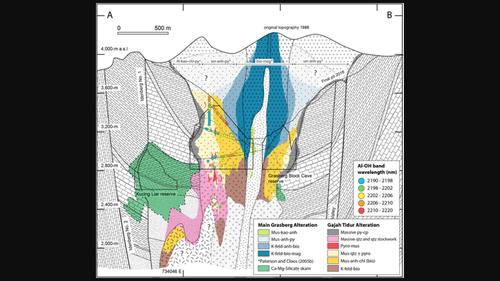Chemical and short‐wave infrared characteristics of white mica associated with the Gajah Tidur porphyry copper system at the deep Grasberg Cu—Au—(Mo) deposit, Indonesia
IF 0.8
4区 地球科学
Q3 GEOLOGY
引用次数: 0
Abstract
The Grasberg Cu—Au—(Mo) deposit comprises the shallower Main Grasberg porphyry Cu—Au and the deeper Gajah Tidur (GT) porphyry Cu—Mo—(Au) systems. The GT porphyry preserves various types of white mica whose geochemical variations provide insights into the white mica‐dominated alteration of porphyry systems. The white mica assemblages within the GT porphyry system comprise: (1) muscovite‐anhydrite‐chlorite (MAC), (2) muscovite‐chlorite‐anhydrite (MCA), and (3) muscovite‐quartz ± pyrophyllite (MQP). These assemblages display zonation from central and deep parts of the system to its shallower and peripheral parts. The MAC alteration white micas are characterized by high Na, Fe, Ti, and V concentrations, and with short‐wave infrared Al—OH absorption wavelengths of 2203–2208 nm. The MCA white micas have higher Mg content than the other two GT white mica assemblages but similar Al—OH absorption wavelengths to the MAC white micas. The MQP alteration white micas have low Na, Fe, Mg, and Ti, but relatively high Si, Al, and F, and Al—OH absorption wavelengths are largely shorter than 2202 nm. We interpret that the high Fe and Ti content of the MAC white micas is due to inheritance of these elements from mafic minerals they replaced. The higher Fe content of these white micas explain their longer wavelength Al—OH absorption positions relative to the MQP white micas. In contrast, lower Fe content and shorter Al—OH wavelengths of the MQP white micas are caused by their higher Si and Al content, which reduces iron occupancy in the white mica crystal structure. White micas in this assemblage formed at lower temperature and probable lower pH condition that may have led to a replacement of Fe by Al. The short‐wave infrared Al—OH position of white mica together with the associated hydrothermal assemblage can be used as a proximitor for porphyry Cu hydrothermal centres. White mica associated with chlorite, anhydrite, and chalcopyrite, which commonly occur overprinting or adjacent to the potassic alteration center, are characterized by Al—OH absorption positions at 2200–2215 nm. By contrast, white mica associated with quartz‐pyrite are characterized by Al—OH wavelengths shorter than 2202 nm. In the distal part of porphyry Cu system, white micas may be associated with chlorite and have Al—OH absorption positions longer than 2204 nm.

印尼Grasberg Cu-Au - (Mo)矿床深部Gajah Tidur斑岩铜体系白色云母化学及短波红外特征
Grasberg Cu-Au - (Mo)矿床包括浅层Main Grasberg斑岩Cu-Au和深部Gajah Tidur (GT)斑岩Cu-Mo - (Au)体系。GT斑岩保存了多种类型的白云母,其地球化学变化为研究白云母主导的斑岩体系蚀变提供了线索。GT斑岩系统中的白色云母组合包括:(1)白云母‐硬石膏‐绿泥石(MAC),(2)白云母‐绿泥石‐硬泥石(MCA),(3)白云母‐石英±叶蜡石(MQP)。这些组合显示了从系统的中心和深层到较浅和外围部分的分区。MAC蚀变白色云母具有较高的Na、Fe、Ti和V浓度,短波红外Al-OH吸收波长为2203 ~ 2208 nm。MCA白云母的Mg含量高于其他两种GT白云母组合,但Al-OH吸收波长与MAC白云母相似。MQP蚀变白云母的Na、Fe、Mg、Ti含量较低,而Si、Al、F含量较高,Al - oh吸收波长大多短于2202 nm。我们认为MAC白云母的高铁和高钛含量是由于这些元素从它们所取代的基性矿物中遗传而来的。这些白云母中较高的铁含量解释了它们相对于MQP白云母具有更长的波长Al-OH吸收位置。相比之下,MQP白云母中较高的Si和Al含量导致其Fe含量较低,Al - oh波长较短,从而降低了铁在白云母晶体结构中的占比。该组合中的白色云母形成于较低的温度和可能较低的pH条件下,可能导致Fe被Al取代。白色云母的短波红外Al - oh位置以及相关的热液组合可以作为斑岩Cu热液中心的近似值。白色云母与绿泥石、硬石膏和黄铜矿伴生,通常叠印或靠近钾蚀变中心,其Al-OH吸收位置在2200 ~ 2215 nm。相比之下,与石英-黄铁矿伴生的白色云母的Al-OH波长短于2202 nm。在斑岩Cu体系的远端,白色云母可能与绿泥石伴生,其Al-OH吸收位置大于2204 nm。
本文章由计算机程序翻译,如有差异,请以英文原文为准。
求助全文
约1分钟内获得全文
求助全文
来源期刊

Resource Geology
地学-地质学
CiteScore
2.30
自引率
14.30%
发文量
18
审稿时长
12 months
期刊介绍:
Resource Geology is an international journal focusing on economic geology, geochemistry and environmental geology. Its purpose is to contribute to the promotion of earth sciences related to metallic and non-metallic mineral deposits mainly in Asia, Oceania and the Circum-Pacific region, although other parts of the world are also considered.
Launched in 1998 by the Society for Resource Geology, the journal is published quarterly in English, making it more accessible to the international geological community. The journal publishes high quality papers of interest to those engaged in research and exploration of mineral deposits.
 求助内容:
求助内容: 应助结果提醒方式:
应助结果提醒方式:


